So the Defence Capability Plan 2019 was released in June 2019 it covers the defence spending out to about 2030 of what type new equipment the NZDF will receive, although not saying exactly what they will buy for example a 2nd enhanced sealift vessel for RNZN but only basically say it's capability, not what the actual vessel is or where they will get it built or even the exact style of the vessel. There are many options from LPD's too small LHD's.
Suggested new naval purchases also contribute to these broader strategic objectives. HMNZS Canterbury’s sea-state ratings for landing craft operations are limited, so a new landing platform dock that has a greater cargo capacity can cope with higher sea state, has a shallow draught and has improved self-protection capability would improve potential contributions in the Pacific.
The DCP-2019 basically says that the government have recognised the value of a sealift vessel, but the current vessel has limitations and the new vessel the want to rectify these limitations, and the main limitation is lack of a well dock on HMNZS Canterbury.
Noting the value and capabilities of what HMNZS Canterbury the NZG and MoD want more, the new vessel will be larger and more capable, needs to carry more equipment, more troops and least the same number of helo's which is x3 NH-90 and x1 SH 2G(I) SeaSprite.
Because Canterbury doesn't have a well dock, Canterbury can carry quite a sizable load for the size of the vessel with 40-50+ vehicles (depending on load out a vehicle size etc) and x33 20 foot containers. Canterbury also has a 5 bed hospital, and 2 bed sickbay, an operation theatre, a morgue, scientific labs, various workshops, gym, an armory, and magazine.
Going by the DCP2019 they want to increase the capabilities in all these area's carry more equipment, more troops, most likely a larger hospital facilities. They want at least the same capabilities in the helicopters capability but possibly more reading between the lines. To be able to launch and recover drones, to be special operations with being able to deploy NZSAS. And the self defence of said vessel should be more that a single 25mm auto cannon and a couple of 50cal HMG's.
Read the full Defence Capability Plan 2019 here. So let's look at what the DCP19 says;
Page 13
|
|---|
and from page 33 and 34
|
|---|
So we know that there will be a second enhanced sealift ship with a proper well dock with in the next 10 years and it will work alongside HMNZS Canterbury not replace her. We also know that it will can carry more troops and personal as well as more equipment, will be able to operate multiple helo's and have enhanced facility's that of HMNZS Canterbury. We also know more that 1 billion + of the 20 billion is budgeted for this vessel.
So let us look at our options for both LPD's as well as some of the smaller LHD's that could meet the NZDF and RNZN's needs, that are set out by the NZG in the DCP19 and which is continually changing. So first let us look and the capabilities of HMNZS Canterbury L421.
One thing to note in this article is calculations on cost and inflation and is only a very quick calculation and can not be taken for granted as many things can happen between now and then and can only be an estimate. I also calculate to 2025/2026 which is roughly when the NZDF, MoD and NZG will make the decision as the request for tender is 2024 and will know the cost of the project. The important thing here is the 1B + the + here is meaning they could budget more if truly needed.
To give an indication on inflation, HMNZS Canterbury in 2005 cost $130 Million or $130,000,000 NZD if we inflate that to 2019, it would cost $172 Million or $172,000,000. Now remember the new LHD/LPD is budgeted a $1 Billion or $1,000,000,000 + and that will be in in around 2025/26 inflated dollars when the contract is expected to be signed.
HMNZS Canterbury - L421

HMNZS Canterbury before her alterations.
|
Type:
|
Multi-role vessel - LPA
|
|---|---|
|
Displacement:
|
9,000 tonnes (full load)
|
|
Length:
|
131 m (430 ft)
|
|
Beam:
|
23.4 m (77 ft)
|
|
Draught:
|
5.4 m (18 ft)
|
|
Propulsion:
|
CODADE (combined diesel and diesel-electric) consisting of 2 Wärtsilä engines @ 4.5 MW, 3 × auxiliary diesels, 2 × bow thrusters
|
|
Speed:
|
19.6 kn (36.3 km/h; 22.6 mph) baseline
16 kn (30 km/h; 18 mph) economical |
|
Range:
|
8,000 nmi (15,000 km; 9,200 mi) at 16 kn (30 km/h; 18 mph)
|
|
Boats & landing
craft carried: |
2 × medium landing craft (23 m) displacement: 55 tonnes (empty), 100 tonnes (full load), crew: 3
2 × RHIB (7.4 m), 300 hp (220 kW), range: 130 nmi (240 km) speed: 35 kn (65 km/h) 2 × special forces RHIB (11 m) as optional cargo |
|
Troops:
|
Up to 250
|
|
Complement:
|
Core: 53 naval, 10 air force, 7 army
Other: 35 trainees, 4 government agents |
|
Sensors and
processing systems: |
Fire control: Vistar Electro-Optical
ESM: CEA Warrlock HFDF Radar: S & X band |
|
Armament:
|
1 × remote-controlled MSI DS25 stabilised naval gun with 25 mm M242 Bushmaster cannon
2 × .50 calibre machine guns Small arms |
|
Aircraft carried:
|
2 × SH-2G Seasprite helicopters. Can be armed with a combination of homing torpedoes, depth charges, Penguin air-to-surface missiles and a MAG58M machine gun. 3 × NH90 helicopters can also be hangared for transport. (After modifications 2014 use to be 4 NH-90) |
|
Aviation facilities:
|
Helicopter deck (stern)
The flight deck can accommodate up to a Chinook sized helo |
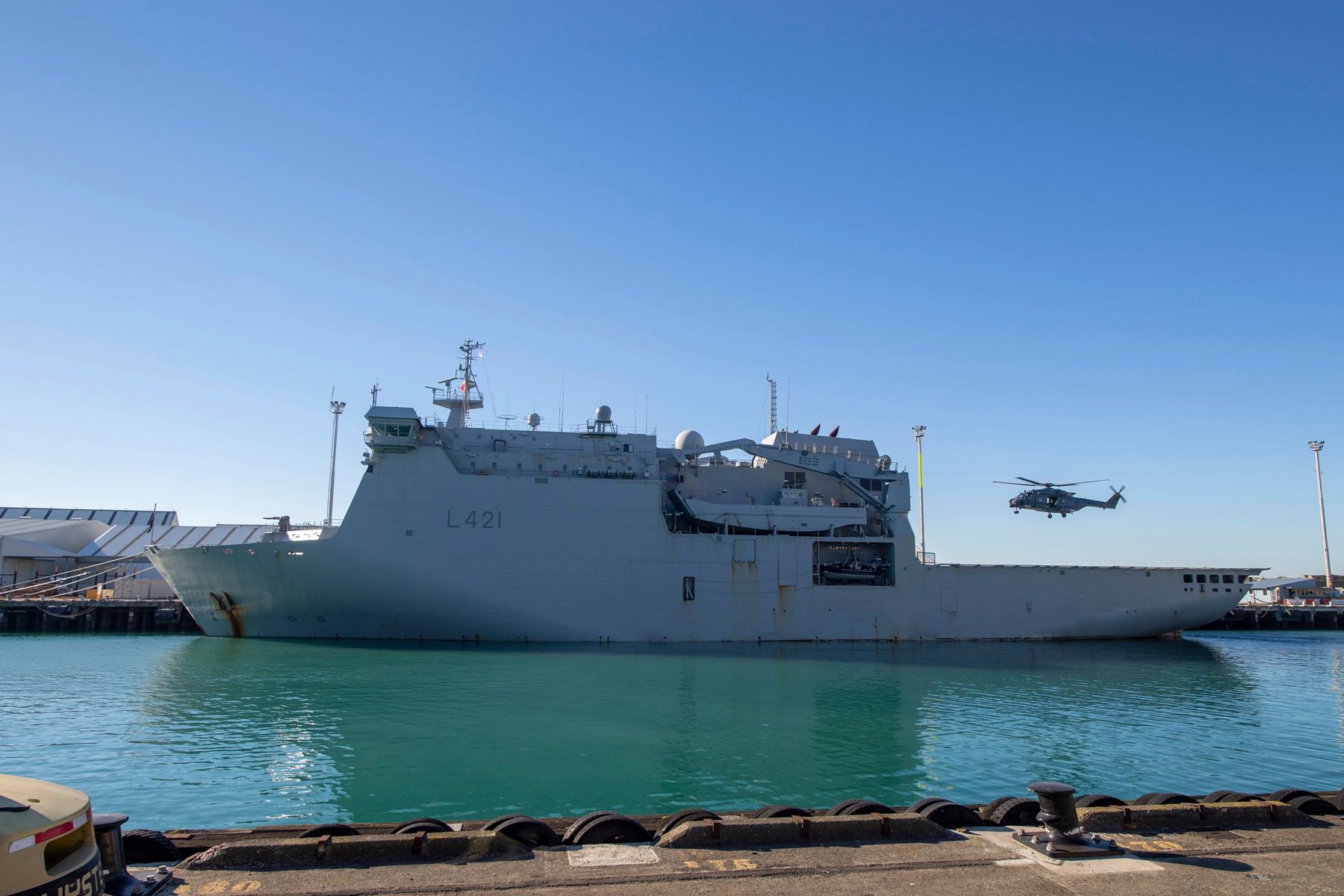
Armaments
As a strategic sealift ship, HMNZS Canterbury is not intended to enter combat zone, or conduct opposed landings under fire. Therefore the ship's armament only consists of a single 25 mm M242 Bushmaster cannon fitted to an MSI DS25 stabilised mount, four .50 calibre machine guns, as well as a number of other small arms. These are intended for self-defence against other smaller craft, and for ocean patrol duties (for example the intercepting of suspicious civilian craft) during a naval blockade. NOTE: There are actually x2 .50 calibre machine guns on each bridge wing.
Facilities
Cargo
The ship has cargo space of 1,451 square metres (15,620 sq ft), which can be unloaded via two ramps, either from the starboard side or the stern.
The indicative cargo would encompass (as one possible loadout): 14 Pinzgauer Light Operational Vehicles, 16 NZLAV light armored vehicles, 7 Unimog trucks, 2 ambulances, 2 flatbed trucks, 7 vehicle trailers, 2 rough terrain forklifts, 4 ATV-type vehicles and up to 33 20 ft TEU containers.
The ship is equipped to embark up to eight containers of ammunition and up to two with hazardous materials, and also has an extensive fire sprinkler system.
This is quite a load out for a ship of this size but because HMNZS Canterbury does no have a well dock which takes up valuable space this extra space is now vehicle lanes.
Landing craft
The ship also carries two Landing Craft, Medium. The landing craft have a length of 23 metres (75 ft) and a displacement of 55 tonnes (empty) to 100 tonnes (loaded with two NZLAVs). They are operated by a crew of three, using two Azimuth thrusters generating 235 kW.
The LCMs can be loaded from either of Canterbury's two 60 tonne cranes or via the stern ramp. To aid stern ramp loading, the MRV is fitted with Flippers to ensure that the LCM are aligned with the MRV. A ballasting system is fitted to allow for safe operations during loading. Once loaded, the LCM can conduct over-the-beach landings, with the boats mainly intended to be able to access beaches in the Pacific where no port facilities are available, for example during humanitarian missions.
- How much for an enhanced sealift vessel?
- Why do I think the Endurance 170 LHD is a good choice for the RNZN.
- Ship to Shore : Amphibious Support Ships in The The Asia-Pacific Region
- Sense of scale
Helicopter facilities
Canterbury was able to accommodate up to four NH90 helicopters for deployment ashore in support of New Zealand Army operations and disaster relief activities. This was reduced to 3 NH-90 after the alterations to the RHIB alcoves and internal ships ladder were made. She is also capable of operating the SH-2G Seasprite and the helicopter deck is able to handle a Chinook-size helicopter.
Medical
Canterbury has a five-bed hospital ward, a two-bed sickbay, an operating theatre, a medical laboratory, and a morgue.
Others
The ship also contains a gym, workshops, an armory, and magazine, as well as offices for government officials embarked (such as Department of Conservation or NIWA scientists).
Alterations
The main thing that HMNZS Canterbury is missing to make her a truly capable vessel is a well dock. But she would probably also have to be longer, else too much space below would be taken up on the dock meaning fewer vehicles she can carry. So she would have to be longer this would have meant that she was not in the 130 million dollar budget...
HMNZS Canterbury had a very rough start in her life, with the loss of a sailor, she had sea keeping issues when she was empty and low on fuel. Canterbury doesn't have standard stabilizing fins and instead uses ballast tanks. This was because she was intended to go south in to the Ross Sea. Her hull is ice strengthened to Polar Class 6. These issues have been addressed an mostly fixed. The RHIB alcoves were moved forward and up, the ships ladders became auto internal ladders, and a good dollop of concrete was added to help with sea keeping when she is travelling light. The alterations meant she can now only carry 3 NH-90 and a Seasprite not 4.
All this said and done HMNZS Canterbury is showing her worth, she has done multiple HADR missions in the Pacific including the Christchurch and Kaikoura earthquakes, resupply missions and and exercises, from the US led Pacific Partnership, to RIMPAC, to Exercise Talisman Sabre, Southern Katipo, Exercise Joint Waka, Exercise Croix du Sud,and a variety of others without issues. She is also a good training ship where a variety of trainees can learn their trade.
Is she perfect, no. Is she a stepping stone to learn full amphibious operations, yes. while she will never be able to fully meet the original requirements set out by the government of the time, ie; I can not see her travelling to the Ross sea etc, the navy have learnt what they can and can not do with her. The Government can see the advantage of having a capable strategic sealift vessel hence the requirement of an enhanced vessel set out by the DCP2019.
LPD - Landing Platform Dock
So the DCP says "a Landing Platform Dock is an example of the type of vessel that will be considered." and while that is most likely what we will get it is not our only options as stated above some LPD's are as big as the smaller LHD's and lot more expensive.
The budget of more than 1 billion NZD is a lot of LPD even when you take in consideration of the LCM's and when I say a lot I mean a lot and it if you going to spend that much on an LPD, then might well spend the same money on a smaller LHD and have that enhanced helo operations which give an overall enhanced performance and even minor force projection.
Now I am not suggesting that the options I post here are the only options or the right options, I am just saying they are options. The other thing is, many of the options are not much more than HMNZS Canterbury can do but has a well dock... For this article, I will be using info found on Wiki and while it won't be 100% accurate it will be close enough for this article. So let us look at some options;
San Giorgio-class amphibious transport dock
The San Giorgio class is an amphibious assault ship, a type of helicopter carrier, of the Italian Navy. These ships can carry a battalion of troops and up to 36 armored vehicles. The stern floodable dock can accommodate three landing craft. The ships are based at the Brindisi naval base on the Adriatic coast.
San Giorgio and San Marco have been extensively modified into landing helicopter docks. They accommodate a full-length flight deck with four landing spots. San Giusto, the third vessel, has not been modified since construction, however, featured an improved design, and is normally employed as a training ship.
The issue I have with the San Giorgio class is there is no hanger for the helo's and they have stay on the upper deck which is okay for calm sea's but not so much for open ocean of the Pacific, Tasman Sa and the Southern Ocean. So not suitable for the RNZN.
.jpg)
The Italian Marina Militare amphibious transport dock San Marco (L9893) underway in the Mediterranean Sea on 16 June 2016.
| Cost: | $291 million |
|---|---|
| Type: | Amphibious transport dock |
| Displacement: | - 7.960 t (7.834 long tons) full load - 8.000 t (7.874 long tons) for San Giusto (full load) |
| Length: | 133 m (436 ft) |
| Beam: | 20.5 m (67 ft) |
| Propulsion: | - 2 x diesel engines Grandi Motori Trieste GMT A 420.12, 6,264 kW (8,400 hp) each - 4 x diesel engine generators Grandi Motori Trieste GMT B230.6, 770 kW (1,030 hp) each |
| Speed: | 21 knots (39 km/h; 24 mph) |
| Range: | 7,500 nautical miles (13,900 km; 8,600 mi) at 16 knots (30 km/h; 18 mph) |
| Boats & landing craft carried: |
- 3 x LCM62-class LCM - 3 x MTP96-class LCVP - 1 x patrol craft |
| Capacity: | 350 troops with 30 medium tanks or 36 tracked armored vehicles |
| Complement: | 17 officers, 163 ratings |
| Sensors and processing systems: |
- SMA MM/SPQ 702 search radar - GEM Elettronica navigation radar: MM/SPN-748 then MM/SPN-753(V)9 and now dual-band radar (X/Ka) MM/SPN-760(V)1 - Selex ES RTN-10X fire control radar Electronic warfare & decoys: Elettronica SpA INS-3 ECM/ESM suite |
| Armament: | - 1 × Otobreda 76 mm gun (removed from San Giorgio and San Marco to increase flight deck space) - 2 × OTO Melara KBA 25/80 mm guns |
| Aircraft carried: | 3 x AW-101 , 5 x Agusta Bell AB-212 helicopters or 18 SH90A |
| Aviation facilities: | Flight deck However no hanger. |
| Notes: | - San Giusto has a full load displacement 300t greater than the other ships in the class - Italian ships in class include: San Giorgio (L9892) - San Marco (L9893) - San Giusto (L9894) - Algerian ship in class include only Kalaat Béni Abbès, armed with Aster 15 missiles - one similar ship on order for the Qatari navy. |
Cost 291 million USD, however, this is most likely from 1998 cost and therefore we have to add inflation to 2025 dollars but will be well within the 1 billion NZD budget. (would be around roughly 700 million NZD) However, the load capacity is similar to that what we have now with HMNZS Canterbury the only advantage is the well dock. However, a disadvantage is access to a hanger for deployment for the helo's. I am not 100% sure if the Algerian amphibious transport dock Kalaat Béni Abbès has a lift to the hanger or not, but I am pretty sure the older vessels like San Marco don't.
I personally don't see much of advantage over what we can do now with HMNZS Canterbury other than the well dock and hospital space.
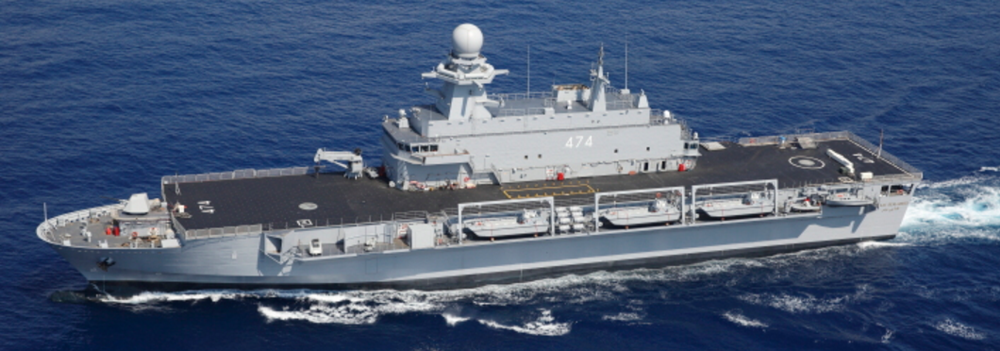
Algerian amphibious transport dock Kalaat Béni Abbès underway
Kalaat Beni Abbes (L-474) is an amphibious transport dock of the Algerian National Navy. The ship built by the Italian firm Fincantieri as an enlarged and improved version of the San Giorgio class. The ship measures 143 metres (469 ft) long and 21.5 metres (71 ft) wide.
The ship has a continuous flight deck with two deck-landing spots for helicopters at the bow and stern.
Ordered in 2011, the ship was commissioned by the Algerian National Navy on 4 September 2014.
The first official docking - and commissioning ceremony - was on 28 March 2015 in the presence of the Chief of Staff of the ANP and the High Command of the Algerian National Navy. The ship has an opening dock to the rear which allows it to launch up to three landing craft. The port side of the ship has davits which are able to launch three landing craft, and two fast boats for commandos. The ship also houses a garage for 15 heavy tanks and housing for 440 soldiers plus 150 crew. The ship also carries a 60-bed hospital and operating theaters.
With only two landing spots it becomes limiting for the helo operations. However the there is a lift to the hanger allowing helo maintenance and increased helo operations.
In 2011 she cost $298 million and is easily with 1 Billion + NZD. But is it the right choice. I personally believe there are better options available.
Makassar-class landing platform dock
The Makassar class is a class of South Korea designed and build Landing Platform Dock. The ships designed by Daesun Shipbuilding & Engineering Co and based on the earlier company product Tanjung Dalpele class that sold to the Indonesian Navy.
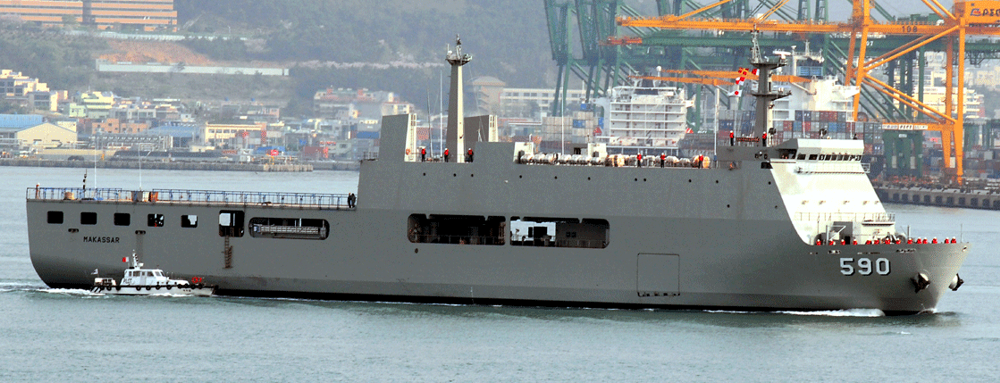
KRI Makassar.
| Type: | Landing Platform Dock |
|---|---|
| Displacement: | Tonnage: 8400 tons 7,300 tons standard displacement 11,394 tons full displacement |
| Length: | 122 meters ~ 125 meters (for Indonesian version) 122 meters (for Peruvian version) |
| Beam: | 22 meters |
| Height: | 56 meters |
| Draft: | 4.9 meters |
| Decks: | (Tank Deck); 6.7 meter,(Truck Deck); 11.3 meter |
| Propulsion: | CODAD, 2 shafts 2 × MAN B&W 8L28/32A diesel rated at 2666 BHP/1960 kW@ 775 RPM |
| Speed: | Maximum: 16 knots Cruising: 14 knots Economy: 12 knots |
| Range: | 30 days, up to 10,000 Nm |
| Endurance: | +45 days |
| Boats & landing craft carried: |
2 x LCVP |
| Capacity: | Up to 40 infantry vehicles |
| Troops: | 218 troops |
| Complement: | Accommodations up to 518 persons |
| Crew: | 126 crew |
| Armament: |
1 x Bofors 40mm SAK40/L70 |
| Aircraft carried: | Up to 5 helicopters |
| Aviation facilities: | 2 helideck spot (Mil Mi-17) |
While Makassar LPD meets some of the requirements (well dock) it actually lacks in others area's ie; HMNZS Canterbury can carry 250+ Troops vs Makassar 218 but however a total (including crew) of up to 518 short term. There is no number given for Canterbury's short term number for troops. However if Canterbury is not carrying any trainees she can take on a few more troops, (including crew total of 366 long term). As stated Canterbury has not got a number for short term troop numbers. The DCP 2019 asks for the ability to carry more (and that would be long term)
HMNZS Canterbury can carry three medium-sized NH-90 (use to be 4) plus a Seaprite, while Makassar states it can carry five helicopters, it doesn't actually say what size. Although the actual flight deck would be about the same as Canterbury and land x2 Mil Mi 7 apparently ie; Canterbury could probably fit five SeaSprites into the hangar... as they smaller than the NH-90...(not saying she actually can) but you get the idea.
The advantage Canterbury has with not having a well-dock, is that space is used for taking vehicles and equipment, the ship has cargo space of 1,451 square metres of cargo space which is actually quite a lot so Makassar having a well-dock chews up space ... it only says up to 40 infantry vehicles... not really stating size of the vehicles... how many LOV, or LAV etc.
Here is a typical load for Canterbury...The indicative cargo would encompass (as one possible loadout): 14 Pinzgauer Light Operational Vehicles, 16 NZLAV light armoured vehicles, 7 Unimog trucks, 2 ambulances, 2 flatbed trucks, 7 vehicle trailers, 2 rough terrain forklifts, 4 ATV-type vehicles, and up to 33 20 ft TEU containers... If the containers aren't there... there is more space for vehicles and equipment... but the load is roughly 40 infantry vehicles (if not more) plus the containers. I remember back in errr 2007/8 ish a test embarkation and disembarkation was 250 troops and 50 vehicles, including 20 NZLAV's and I thought damn that's quite a few vehicles... Again the DCP 2019 wants more a larger load capacity...
- Why do I think the Endurance 170 LHD is a good choice for the RNZN.
- A closer look at the Endurance 160 LHD
These vessels are built pretty cheaply as well, around 70 mil USD although would be more than this now as that was 2004/5... The DCP 2019 stats it is setting aside more 1 Billion+ NZD you could probably get 5 or 6 of these, or get a decent, truly enhanced sealift vessel, with enhanced flight operations as well. My point is 1 Billion+ is a hell of a lot for and LPD (unless you get it built in the US, Canada, Europe or Australia... (then well) overall she is smaller, slower than HMNZS Canterbury and the only thing I can see that the Makassar class can do better is it has a well-dock.
Ōsumi-class tank landing ship
The Ōsumi class LST, is a Japanese amphibious transport dock. The class is also known as the Oosumi class. While the JMSDF describes the Ōsumi class as tank landing ships, they lack the bow doors and beaching capability traditionally associated with LSTs. Functionally, their well-deck makes the Ōsumi class more like a dock landing ship (LSD).
As of 2014, there are 3 Ōsumi vessels active with the Japanese Maritime Self-Defence Force.
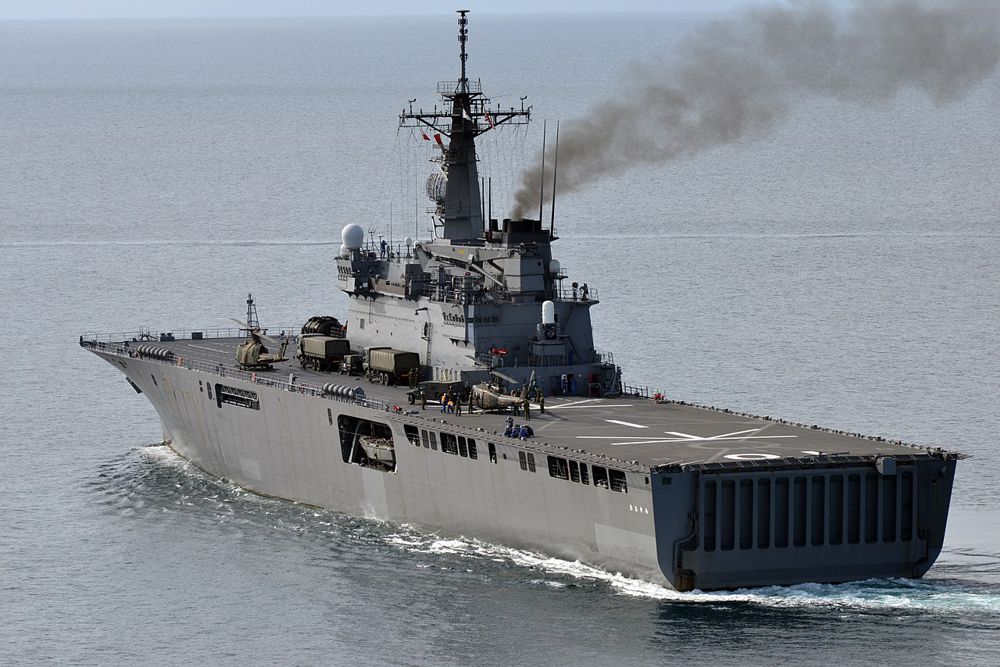
| Class and type: | Ōsumi class LST |
|---|---|
| Displacement: | 8,900 tons standard 14,000 tons full load |
| Length: | 178 m |
| Beam: | 25.8 m |
| Draft: | 6.0 m |
| Propulsion: | 2 × Mitsui 16V42M-A Diesel (2 shafts propulsion, 26,000 bhp.) 1 × bow thruster |
| Speed: | 22 knots (41 km/h) |
| Complement: | 138 crews + (330 troops) |
| Sensors and processing systems: |
OPS-14C air search radar,OPS-28D surface search radar,OPS-20 navigation radar, TACAN |
| Electronic warfare & decoys: | 4 × Mark 36 SRBOC |
| Armament: | 2 × 20 mm Phalanx CIWS 2 × 12.7mm machine gun M2 |
| Aircraft carried: | Up to 8 helicopters |
| Notes: | Two Landing Craft Air Cushion (LCAC) Troops: 330/1000 long/short duration Up to 10 main battle tanks |
I don't believe this vessel is large enough to accommodate the equipment the NZDF would like to deploy even if it wasn't carrying any helo's. One of the reasons Canterbury can carry so much equipment and vehicles is because she does not have a well-dock which takes up precious space... however the DCP is saying the new vessel will have the well-dock making this class a little bit limited. Also on the older side and design nearing 21 at the time of writing and will be retiring by the time the RNZN introduce the new enhanced sealift vessel vessel.
Rotterdam Class LPD
She was the result of a joint project between the Netherlands and Spain, which resulted in the Enforcer design. The ship is equipped with a large helicopter deck for helicopter operations and a dock for large landing craft. The ship has a complete Class II hospital, including an operating theater and intensive care facilities. A surgical team can be stationed onboard. The ship also has a desalination system enabling it to convert seawater into drinking water.
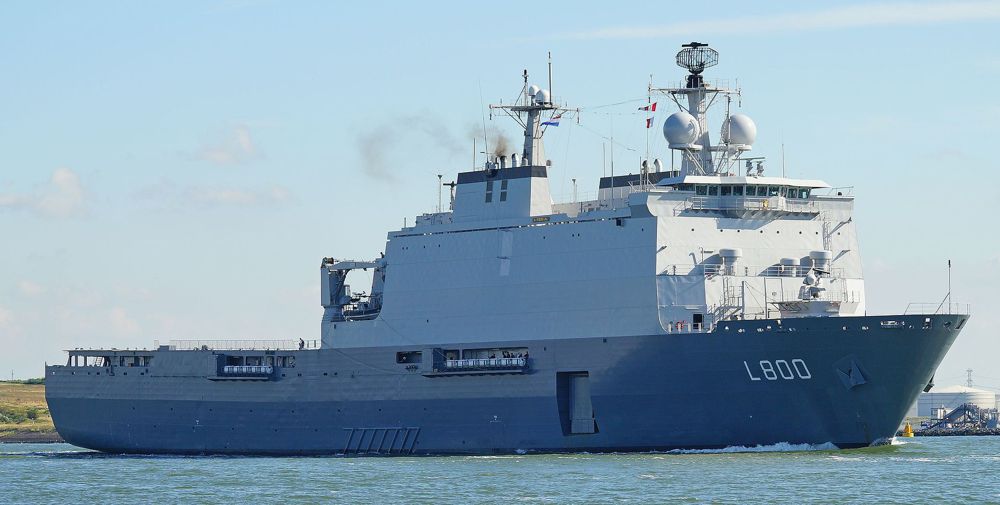
|
Type:
|
Landing platform dock
|
|---|---|
|
Displacement:
|
12,750 t
14,000 full load |
|
Length:
|
166 metres (545 ft)
|
|
Beam:
|
27 metres (89 ft)
|
|
Draft:
|
6 metres (20 ft)
|
|
Propulsion:
|
Diesel-electric system
4 × Stork Wärtsilä 12SW28 diesel generators at 14.6 MW 4 × Holec electric motor (two in tandem per shaft) at 12 MW 2 shafts bow thruster |
|
Speed:
|
19 knots (35 km/h; 22 mph)
|
|
Range:
|
6,000 nautical miles (11,000 km; 6,900 mi) at 12 knots (22 km/h; 14 mph)
|
|
Endurance:
|
6 weeks
|
|
Boats & landing
craft carried: |
4 x LCVP
|
|
Capacity:
|
90 armoured personnel carriers or 32 main battle tanks
|
|
Troops:
|
611 marines
|
|
Crew:
|
128
|
|
Sensors and
processing systems: |
DA08 air/surface search
IRSCAN SATCOM, Link 11, JMCIS |
|
Electronic warfare
& decoys: |
1 × AN/SLQ-25 Nixie torpedo decoy
|
|
Armament:
|
2 × Goalkeeper CIWS guns
8/10 × Browning 12.7 mm machine guns |
|
Aviation facilities:
|
Hangar for 6 x Agusta Westland Lynx or 3 x NH-90 or AS-532 Cougar helicopter and stern helicopter flight deck
|
My concerns though are, again like many on this list she is an older design, and there are newer and better designs out there she will be a 20+ year old and her designs comes from the 1990's. It is limited to 3 NH-90 which is what HMNZS Canterbury can carry plus the Sea Sprite, and reading between the lines I believe the DCP 2019 is wanting to be able to carry/operate more helo's.
However this vessel is adaptable and the HNLMS Johan de Witt (L801) is quite a capable vessel she is larger and can carry 6 NH-90 (although I would suggest that flight operations would be limited from the flight deck and she does what Canterbury does now with sending them to a FOB (forward operating base) but could meet the requirements of the DCP 2019,
This vessel cost ƒ265m in 2003 which equates to about $225m NZD, add inflation for 2019 adds about $290m NZD. Add inflation for 2025/6 and we have a figure of about $350m NZD, I then ask if they roughly know the price of these vessels, why is more 1 billion + NZD being set aside. We could buy 2 of these vessels with cash left over. This would not cost 1 billion + NZD even in 2025 inflation dollars.
Even the much larger HNLMS Karel Doorman JSS vessel in 2011 cost $480 million USD and in 2021 would be $764 Million NZD and in 2029 be only just over the 1 billion NZD at $1,036,000,000 but remember that the agreed cost will be before 2029 an just about guaranteed built else where like South Korea lowering the cost. Example contract signed in say 2025 the cost would $957 million. Also remember Inflation is difficult to work out.
Endurance class – LPD
The Endurance-class landing platform dock ships (LPD) are the largest class of ships in the Republic of Singapore Navy (RSN). They were designed and built by Singapore Technologies (ST) Marine to replace the old County-class tank landing ships (LST). The four ships form the 191 Squadron of the RSN.
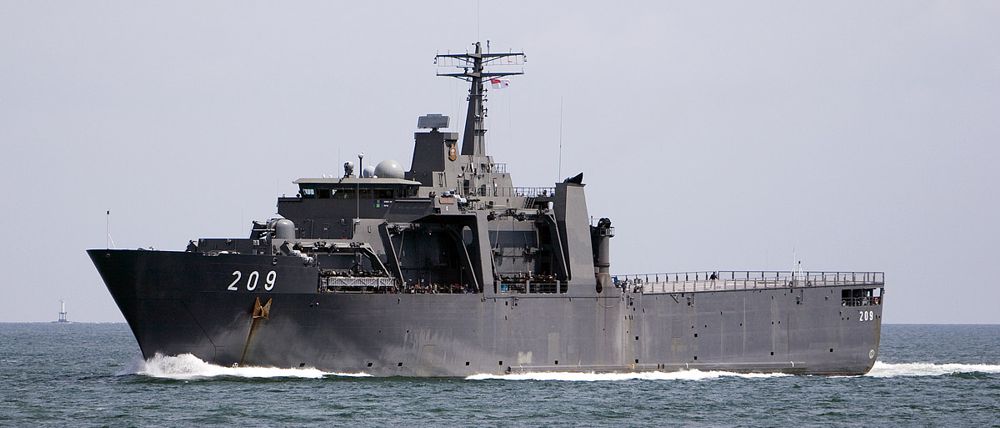
RSS Persistence (209) in the Singapore Straits
|
Type:
|
Landing platform dock
|
|---|---|
|
Displacement:
|
Standard: 6,500 t (6,400 long tons; 7,200 short tons)
Full load: 8,500 t (8,400 long tons; 9,400 short tons) |
|
Length:
|
141.0 m (462 ft 7 in)
|
|
Beam:
|
21.0 m (68 ft 11 in)
|
|
Draught:
|
5.0 m (16 ft 5 in)
|
|
Ramps:
|
2 × (bow and stern)
|
|
Installed power:
|
4 × Ruston 6RK215 diesel generators, each producing 875 kW (1,173 hp)
|
|
Total output:
|
3,500 kW (4,690 shp)
|
|
Propulsion:
|
Combined diesel and diesel (CODAD) arrangement
2 × Ruston 16RK 270 diesels, each producing 5,500 kW (7,400 hp), coupled to two Kamewa controllable-pitch propellers |
|
Total output:
|
11,000 kW (14,800 shp)
|
|
Speed:
|
In excess of 15 kn (28 km/h; 17 mph)
|
|
Range:
|
5,000 nmi (9,300 km; 5,800 mi) at 15 kn (28 km/h; 17 mph)
|
|
Boats & landing
craft carried: |
4 × 13 m (43 ft) Fast Craft Equipment & Utility (FCEU) on davits
2 × 25 m (82 ft) Fast Craft Utility (FCU) inside well deck |
|
Capacity:
|
18 tanks, 20 vehicles and bulk cargo
|
|
Troops:
|
> 350–500
|
|
Crew:
|
65 (8 officers and 57 men)
|
|
Sensors and
processing systems: |
Search radar: IAI/ELTA EL/M-2238
Navigation radar: Kelvin Hughes Type 1007 (I band) Weapon control: CS Defense NAJIR 2000 electro-optronic director |
|
Electronic warfare
& decoys: |
ESM/ECM: RAFAEL RAN 1101
Decoys: 2 × GEC Marconi Marine Shield III 102 mm sextuple fixed chaff/decoy launcher |
|
Armament:
|
Anti-air: Mistral missiles launched from 2 × Simbad twin launcher mounts
Main gun: 1 × Oto Melara 76 mm super rapid gun Autocannons: 2 × 25mm M242 Bushmaster Mk 38 Mod 2 (with stabilised Typhoon weapon sighting system, mounted amidships on port and starboard side) Machine guns: 4 × STK 50MG 12.7 mm (0.50 in) HMGs |
|
Aircraft carried:
|
AS 332M Super Puma or AS532UL/AL Cougar or CH-47SD Chinook helicopters
|
|
Aviation facilities:
|
Flight deck and enclosed hangar for up to 2 medium-lift helicopters
|
She has the well-dock and can carry the extra troops and equipment, but the DCP states it also must have equal or more helo capability. Even after the alteration done to HMNZS Canterbury, she can still carry in the hanger 3 NH-90's and 1 SeaSprite (it use to be 4 NH-90) or mix thereof, so the helo operations are same but can not carry the extra medium-sized helo for shore operations. The other thing she can carry 18 tanks, 20 vehicles, and bulk cargo basically the same as Canterbury can now if not Canterbury could squeeze in more. The only advantage is the Well Dock however the DCP is asking for more.
Remember Canterbury's indicative cargo would encompass (as one possible loadout): 14 Pinzgauer Light Operational Vehicles, 16 NZLAV light armoured vehicles, 7 Unimog trucks, 2 ambulances, 2 flatbed trucks, 7 vehicle trailers, 2 rough terrain forklifts, 4 ATV-type vehicles and up to 33 20 ft TEU containers.
I would also point out with the budget given we could buy a few of these with cash left over.
Dokdo-class amphibious LHD
The Dokdo-class amphibious assault ship is a class of Landing Platform Helicopter (LPH) amphibious assault ships operated by the Republic of Korea Navy (ROKN). Designed by Hanjin Heavy Industries, the requirements for the amphibious landing ships were to enhance South Korea's current amphibious operation capability, both in terms of assault and military operations other than war (MOOTW) type operations.
The ROK Navy required a versatile landing ship with amphibious capabilities in its program to build a blue-water navy. In the end, Hanjin's Dokdo design was chosen for this need. LSF-II 631-also built by Hanjin- was chosen as the LCAC to operate from the ship.

|
Type:
|
Landing Platform Helicopter
|
|---|---|
|
Displacement:
|
14,300 tons (empty) / 18,800 tons (full)
|
|
Length:
|
199 m (653 ft)
|
|
Beam:
|
31 m (102 ft)
|
|
Draught:
|
7 m (23 ft)
|
|
Propulsion:
|
4 SEMT Pielstick 16 PC2.5 STC marine Diesel engine
24 MW (32,000 shp) |
|
Speed:
|
23 knots (43 km/h) maximum
18 knots (33 km/h) cruising |
|
Boats & landing
craft carried: |
2 LCAC (LSF-II)
|
|
Capacity:
|
Up to 200 vehicles (Including Tanks)
|
|
Troops:
|
720 marines
|
|
Crew:
|
330
|
|
Sensors and
processing systems: |
SMART-L air search radar / ELM-2248 (MF-STAR) multifunction surveillance radar, MW08 surface search radar / LIG Nex1 SPS-550K, AN/SPS-95K navigation radar, TACAN, VAMPIR-MB optronic sight
|
|
Electronic warfare
& decoys: |
ESM/ECM:SLQ-200(v)5K SONATA, Chaff launcher
|
|
Armament:
|
2 × Goalkeeper CIWS
1 × RIM-116 Rolling Airframe Missile |
|
Aircraft carried:
|
Up to 15 helicopters (Can support VTOL jets)
|
|
Aviation facilities:
|
Flight deck with 5 landing spots and hangar
|
This vessel cost in 2005 was only $296 million USD, so if we add inflation which would make it around $463 million USD 2019 and then convert to NZD which $612 million but now we have to add inflation for 2025 which the hard part to calculate... But it would be around $755 million. A similar calulations from the ROKS Marado's the sister ship of Dokdo comes to a similar costing. (Remember this is just an estimate as predicting future inflations is very difficult). However I believe that this would be in the budget of "more than 1 Billion NZD."
The draught of 7m does put me off a little, (Canterbury at 5.4m) but still within the usable range in the islands for HADR (Considering HMNZS Aotearoa draught is 8.5m)
Albion-class landing platform dock
The Albion-class landing platform dock is a class of amphibious assault ship in service with the Royal Navy. The class consists of two vessels, HMS Albion and HMS Bulwark, ordered in 1996 to replace the ageing Fearless class. Both ships were built by BAE Systems Marine at the former Vickers Shipbuilding and Engineering yard in Barrow-in-Furness. Albion was commissioned in 2003 and Bulwark in 2004. Each of the ships has a crew of 325 and can accommodate up to 405 troops. Thirty-one large trucks and thirty-six smaller vehicles and main battle tanks can be carried inside the vehicle deck. To disembark troops and vehicles, the vessels are equipped with eight landing craft.
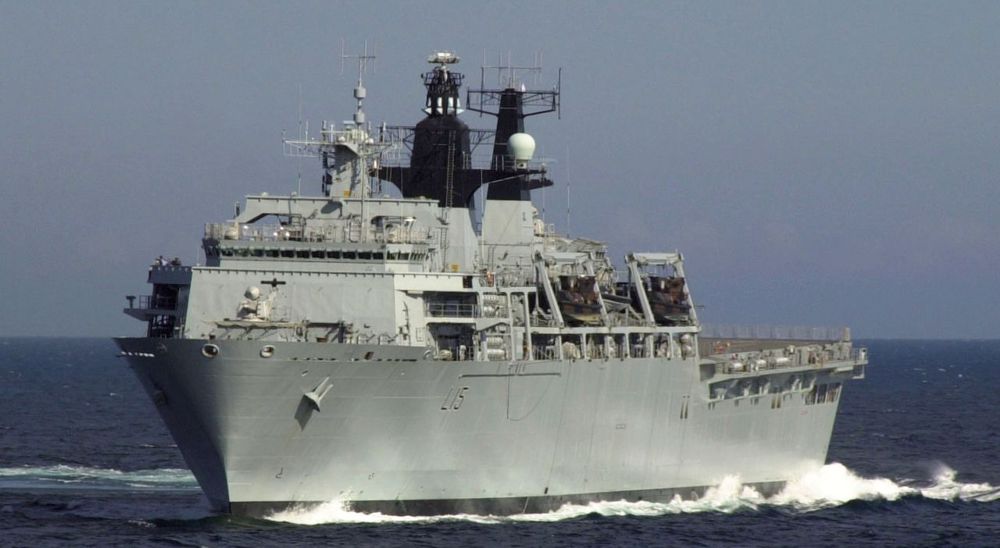
HMS Bulwark, an Albion class landing platform dock of the Royal Navy commissioned in 2004, seen in 2007.
|
Type:
|
Landing platform dock
|
|---|---|
|
Displacement:
|
19,560 t (19,250 long tons; 21,560 short tons)
|
|
Length:
|
176 m (577 ft)
|
|
Beam:
|
28.9 m (95 ft)
|
|
Draught:
|
7.1 m (23 ft)
|
|
Propulsion:
|
2 × Wärtsilä Vasa 16V 32E diesel generators
2 × Wärtsilä Vasa 4R 32E diesel generators GE Power Conversion Full Electric Propulsion System, 2x Motors and Drives and bow thruster |
|
Speed:
|
18 knots (21 mph; 33 km/h)
|
|
Range:
|
8,000 miles (7,000 nmi; 13,000 km)
|
|
Boats & landing
craft carried: |
4 × LCU MK10
4 × LCVP MK5 |
|
Capacity:
|
67 vehicles
|
|
Troops:
|
405 Royal Marines (710 overload)
|
|
Complement:
|
325
|
|
Sensors and
processing systems: |
2 × Type 1007/8 I-band radars
1 × Type 996 E/F band radar 1 × Type 997 E/F-band radar |
|
Armament:
|
2 x 20mm Phalanx CIWS
2 × 30 mm guns 4 × General purpose machine guns |
|
Aviation facilities:
|
Two landing spots for helicopters up-to the size of a Chinook.
|
£225M ($440.25NZD) per ship in 2001 so also an older design and inflation still in the budget about 650mil NZD however one has to remember we have to convert to 2025 NZD which is pretty hard to do but estimating around $760mil NZD. Again a draught of 7.1m is slightly off-putting but in useable range of what we would require. The other thing is no hanger for the helo's and again needs to be able to carry and service if required at least as many (or more) than HMNZS Canterbury currently can. Canterbury can currently hanger x3 NH-90 plus a Seasprite SH-2G(i). Realistically I can not see this on the books. There are simply better options out there.
Bay Class LPD
The Bay class is a ship class of four dock landing ships built for the British Royal Fleet Auxiliary (RFA) during the 2000s. They are based on the Dutch-Spanish Royal Schelde Enforcer design and intended as a replacement for the Round Table-class logistics ships. Two ships each were ordered from Swan Hunter and BAE Systems Naval Ships. Construction work started in 2002, but saw major delays and cost overruns, particularly at Swan Hunter's shipyard. In mid-2006, Swan Hunter was stripped of work, and the incomplete second ship was towed to BAE's shipyard for completion. All four ships, Largs Bay, Lyme Bay, Mounts Bay, and Cardigan Bay had entered service by 2007.
Since entering service, the Bay-class ships have been used for amphibious operations, training of the Iraqi Navy in the Persian Gulf, counter-drug deployments in the Caribbean, and relief operations following the 2010 Haiti earthquake. In 2010, Largs Bay was removed from service as part of the Strategic Defence and Security Review. She was sold to the Royal Australian Navy (RAN) in 2011, who operates her as HMAS Choules.
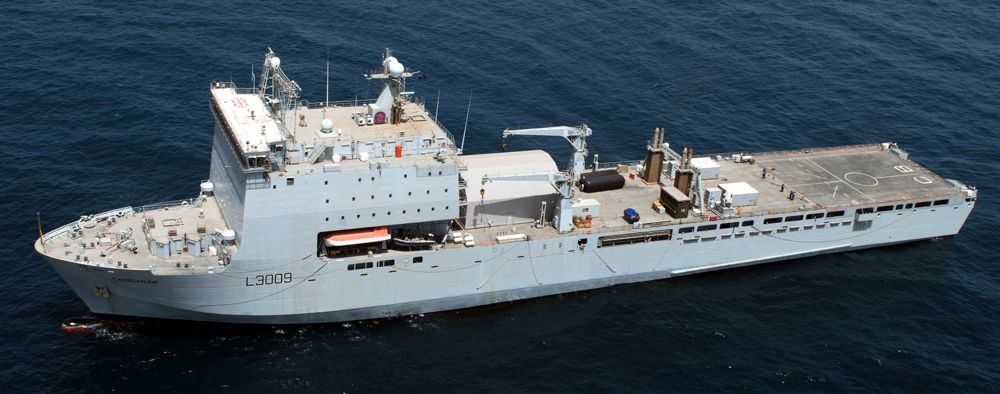
| Type: | Landing ship dock |
|---|---|
| Displacement: | 16,160 tonnes (15,900 long tons; 17,810 short tons) |
| Length: | 579.4 ft (176.6 m) |
| Beam: | 86.6 ft (26.4 m) |
| Draught: | 19 ft (5.8 m) |
| Propulsion: | 2 × Wärtsilä 8L26 generators, 6,000 hp (4.5 MW) 2 × Wärtsilä 12V26 generators, 9,000 hp (6.7 MW) 2 × azimuthing thusters 1 × bow thruster |
| Speed: | 18 knots (33 km/h; 21 mph) |
| Range: | 8,000 nmi (15,000 km; 9,200 mi) at 15 kn (28 km/h; 17 mph) |
| Boats & landing craft carried: |
1 × LCU or 2 × LCVP in well deck 2 × Mexeflote powered rafts |
| Capacity: | 1,150 linear metres (vehicles) 200 tons or 24 TEU (cargo) Troops: 356 (standard), 700 (overload) Crew: 70 (RFA, core only), 158 (RAN) |
| Armament: Fitted for: |
2 × 30mm DS30B cannon 2 × Phalanx CIWS 4 × 7.62mm Mk44 Miniguns 6 × 7.62mm L7 GPMG Individual outfit varies across class |
| Aviation facilities: | Flight deck for helicopters up to Chinook-size |
| Notes: | Derivative of the Enforcer ship design |
The problem with the Bay class is there is no hanger only a add on tent like addition and can really only operate one helo at a time. The DCP states the need to at least be able to carry and service as many helos or more than HMNZS Canterbury currently can. Which would mean major alterations to the stern area for a hanger and may even effect the way the ship handles at seakeeping if a large hanger was added.
The other thing I am unsure about, is while the Bay Class LPD will have a sick bay the DCP is also asking for it to have hospital facilities, HMNZS Canterbury has a five-bed hospital ward, a two-bed sickbay, an operating theatre, a medical laboratory, as well as a morgue. And reading between the lines and this is only speculation, My guess the DCP is asking for larger hospital facilities.
Mistral-class amphibious LHD
The Mistral-class is a class of five amphibious assault ships, also known as a helicopter carrier, of the French Navy. Referred to as "projection and command ships" (French: bâtiments de projection et de commandement or BPC), a Mistral-class ship is capable of transporting and deploying 16 NH90 or Tiger helicopters, four landing barges, up to 70 vehicles including 13 AMX Leclerc tanks, or a 40-strong Leclerc tank battalion, and 450 soldiers. The ships are equipped with a 69-bed hospital and are capable of serving as part of a NATO Response Force, or with United Nations or European Union peace-keeping forces.
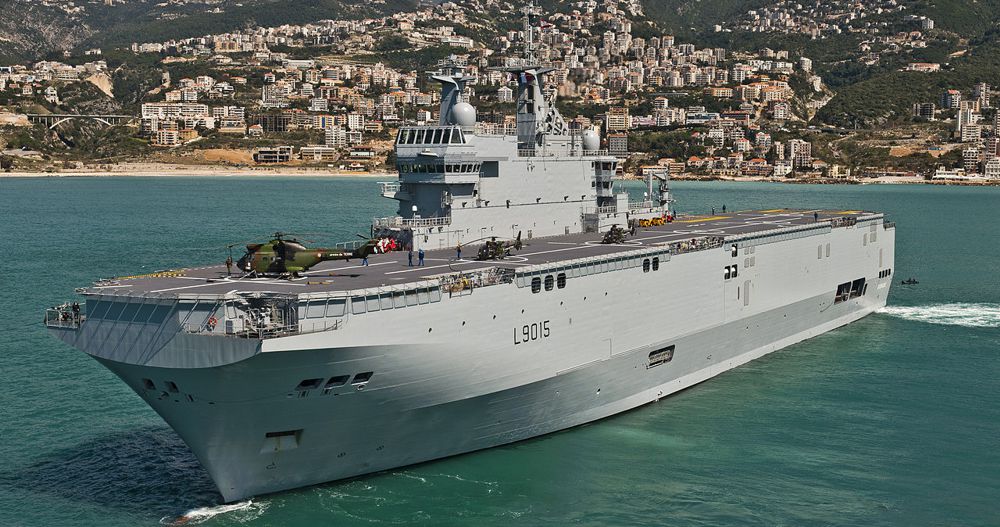
| Type: | Amphibious assault ship - LHD |
|---|---|
| Displacement: | 16,500 tonnes (empty) 21,300 tonnes (full load) |
| Length: | 199 m (653 ft) |
| Beam: | 32 m (105 ft) |
| Draught: | 6.3 m (21 ft) |
| Installed power: | 3 Wärtsilä diesel-alternators 16 V32 (6.2 MW) + 1 Wärtsilä Vaasa auxiliary diesel-alternator 18V200 (3 MW) |
| Propulsion: | 2 Rolls-Royce Mermaid azimuth thrusters (2 × 7 MW), 2 five-bladed propellers |
| Speed: | 18.8 knots (35 km/h) |
| Range: | 10,800 km (5,800 nmi) at 18 knots (33 km/h) 19,800 kilometres (10,700 nmi) at 15 knots (28 km/h) |
| Boats & landing craft carried: |
4 CTM (chaland de transport de matériel) alternatively, 2 LCAC (Landing Craft, Air Cushion) |
| Capacity: | 59 vehicles (including 13 AMX Leclerc tanks) or a 40-strong Leclerc tank battalion |
| Troops: | 900 (short duration) 450 (long durations) 150 (serving as operational headquarters) |
| Complement: | 20 officers, 80 petty officers, 60 quarter-masters |
| Sensors and processing systems: |
DRBN-38A Decca Bridgemaster E250 navigation radar MRR3D-NG air/surface sentry radar 2 optronic fire control systems |
| Armament: | 2 × Simbad systems 2 x NARWHAL 20mm RWS[3] 2 x 7,62 × 51 mm M134 miniguns 4 × 12.7 mm M2-HB Browning machine guns |
| Aircraft carried: | 16 heavy or 35 light helicopters |
| Aviation facilities: | 6 helicopter landing spots |
From memory, this is the vessel the Australian ADF/RAN originally wanted, slightly smaller to what they got, doesn't have the ski ramp.
In 2012 the Mistral-class amphibious assault ship cost €451.6 million. Add inflation to 2021 Euro's it would cost €490.2 million. This is $815.29 NZD. Now again add the inflation of 2% and in 2029 $955 million. But the deal would be made and signed in around 2025/26 and the inflated cost would be $900 million. But again getting it built in South Korea or Singapore would lower costs. Also it is 1 billion + and the + is another variable we don't know... how much of a plus will they be willing to go over.
The problem is that if the deal is signed in around 2025/26 then it is only 3 or 4 years before it enters service in 2029. That even for the South Korean's is pushing it to build and fit out a vessel of this scale in that time frame.
There is also the Mistral 140 which is not as large and only has 5 helo spots etc, which would make her cheaper to build. It would meet the requirements and I do like the design.
Mistral 140
DCNS unveiled a model of a smaller version of the standard Mistral BPC 210 ship called the Mistral 140 in September 2014 at the Africa Aerospace and Defence 2014 exhibition in Pretoria, South Africa.
Compared to the full-sized ship's 21,500 tons displacement and 199 m (653 ft) length with six helicopter landing spots, the 140 would have a displacement of 14,000 tons, 170 m (560 ft) long with five helicopter landing spots. It would be 30 m (98 ft) wide with a range of 6,000 nmi (6,900 mi; 11,000 km) at 15 knots.
| Mistral 210 | Mistral 140 |
| Tonnage: 21,500 tons | 14,000 tons |
| length: 199m (653 ft) | 170m (560 ft) |
| Beam: 32m (105 ft) | 30m (98 ft) |
| Range: 10,800 Km (5,800nmi) | 11,000 (6900 nmi) |
| Helo: 6 landing spots | 5 landing spots |
Like the original plans for the Mistral BPC 210 that have not yet come to fruition, the Mistral 140 would have naval guns at the left stern and at the right side of the bow, with heavy machine gun posts on both sides. There would be a well dock in the stern for landing craft, and two alcoves on each side to launch rigid-hulled inflatable boats, along with a crane positioned amidships behind the superstructure. The hangar deck would have space for ten helicopters, with a 400 m2 joint operations centre for command staff. There would be accommodation for about 500 troops as well as over 30 vehicles and a 30-bed hospital. Propulsion would be provided by two azimuth pods and a bow thruster, probably an all-electric propulsion system like the BPC 210.
DCNS is advertising the Mistral 140 as "a political tool for civilian and military action" for countries that cannot afford the standard Mistral vessels. Roles listed include humanitarian and peacekeeping operations, crisis management, force protection, joint headquarters command, medical and logistics support and transport of military forces. The company is pitching the ship to countries less likely to engage in combat operations which need something more like a multi-role support or logistics ship, particularly the South African Navy.
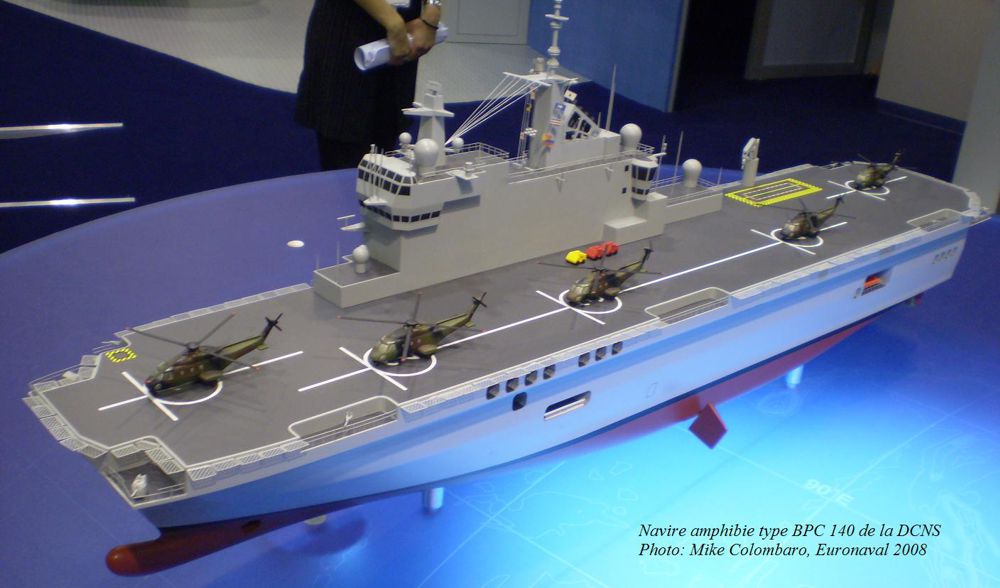
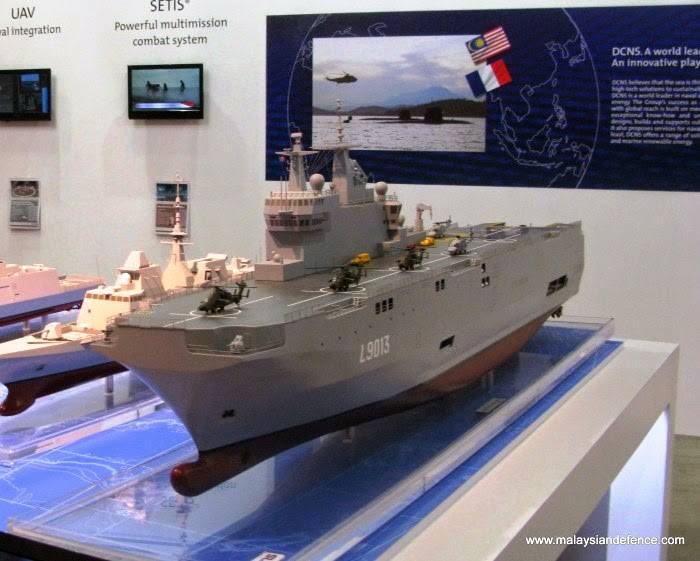
From a design aspect, I believe it needs a second lift like the Endurance 170. But would still be operational as is. My main issue would be still the cost, being a European design. Again if we could get it built in South Korea and or Singapore even Japan, lowering construction costs greatly.
Mistral 170
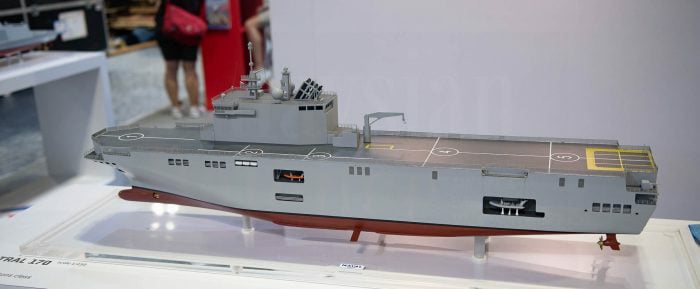
Other option is Mistral 170, sits in between the 140 and the 210
Damen Enforcer 18000 LHD
Damen Enforcer series of LPD's and LHD 18000 range in capability, the LHD, however, hasn't been built by any country as of yet and therefore is an unproven design, it has not gotten past much more than artistry designs. Therefore there is little known about the design, we know the tonnage being 18,000t, estimated 170m in length and 30m beam. 5 helo landing spots. I would suggest that other capabilities would be similar to other LHD's. The LHD's have been built and is used by a few countries the Rotterdam Class LPD is a variation of the enforcer is a well know class of vessel.

Endurance 170 LHD
At IMDEX Asia 2017, the international maritime defence exhibition held last month in Singapore, local shipyard ST Marine unveiled a new addition to its Endurance family: The Endurance 170 Landing Helicopter Dock (LHD).
Based on the existing Endurance 160 design, the new vessel was designed as a multipurpose command and support ship for maritime operations. It can act as a command and logistic support vessel for humanitarian assistance and disaster relief and search and rescue operations. The Endurance 170 LHD can also conduct amphibious operations and project power (troops and equipment) via ship to shore connectors or helicopters.
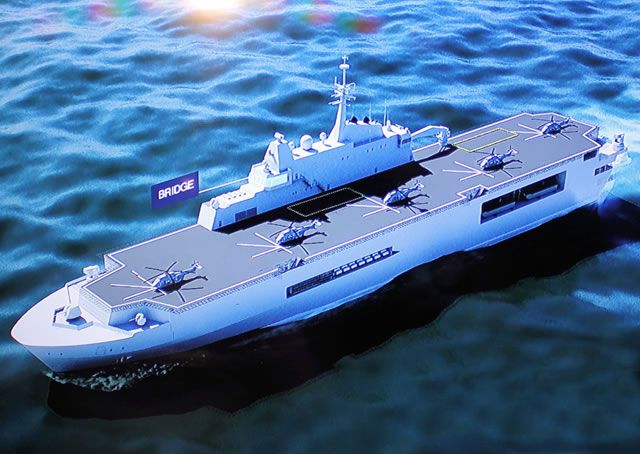
The design features 4,200 square meters of a helicopter deck and 5 helicopter spots on the flat deck. The hangar deck measuring 2,050 square meters can accommodate up to 10 medium-size helicopters.
The design features a well deck as well which can launch and recover four landing craft. Vehicle decks can receive 17 MBTs and 16 armored vehicles.
In terms of sensors and systems, Endurance 170 base configuration consists in a 76mm main gun, 4x 30mm secondary guns, 2x RAM launchers, 16x VLS for SAM, a fire control radar, a 3D surveillance radar, C-ESM and R-ESM sensors, two electro-optic sensors.
The design features a well deck as well which can launch and recover four landing craft. Vehicle decks can receive 17 MBTs and 16 armored vehicles.
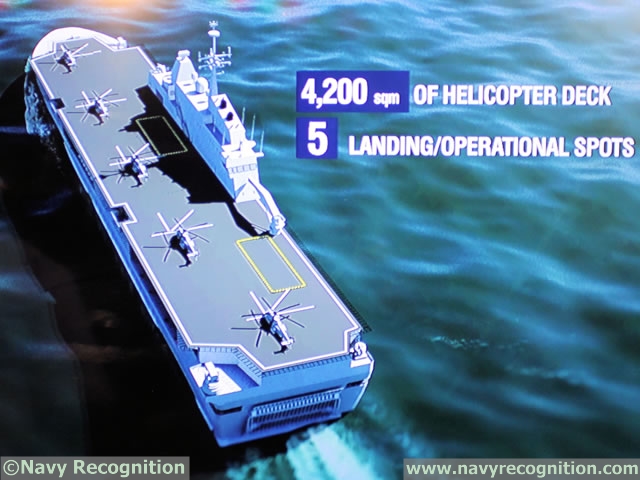
In terms of sensors and systems, Endurance 170 base configuration consists in a 76mm main gun, 4x 30mm secondary guns, 2x RAM launchers, 16x VLS for SAM, a fire control radar, a 3D surveillance radar, C-ESM and R-ESM sensors, two electro-optic sensors.
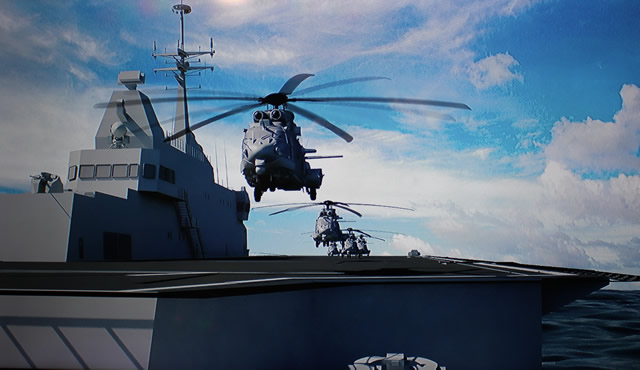
IMDEX Asia 2017: ST Marine Unveiled the Endurance 170 LHD Screen capture from a ST Marine video on Endurance 170
The Endurance 170 has a length of 170 meters, a breadth of 30.80 meters, a draft of 6.60 meters for a full load displacement of 19,000 tons. Here is a thing to consider HMNZS Aotearoa is technically larger and heavier at 173.2m, beam for 24.5m and draft 8.5m and at 26,000 tons.
The ship crew complement is 140 sailors, the aircrew 150 sailors and the vessel can accommodate 400 troops.
The design has a maximum speed of 20 knots, a range of 7000 nautical miles at 15 knots and an endurance of 30 days at sea.
ST Marine has both the domestic and export market insight with this design. As we reported in February during NAVDEX, ST Marine teamed up with local shipyard ADSB to propose an LHD design to the UAE Navy.
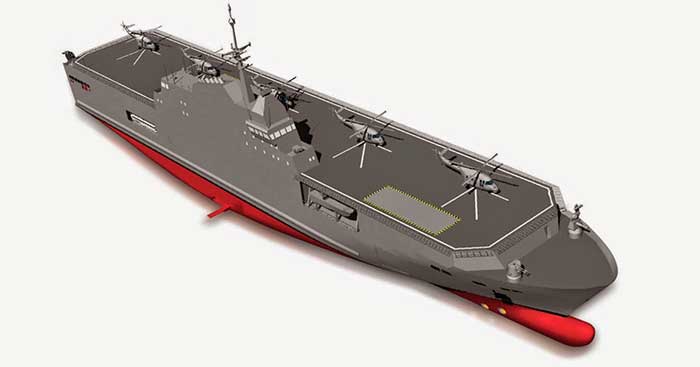
Endurance 160
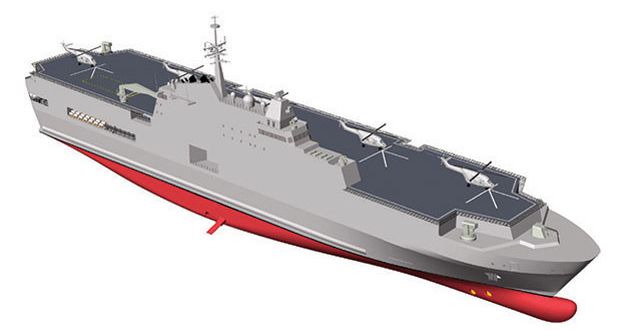
Endurance 170
The Republic of Singapore Navy (RSN) is also known to have a future requirement for a large amphibious vessel to supplement its existing, ST Marine-built Endurance-class of landing platform docks (LPD). The RSN operates four LPDs of this class displacing 8,500 tons. (see above Endurance 140) ST Marine is likely to face fierce competition from international shipyards, however. DCNS of France was showcasing its Mistral-class LHD and Huntington Ingalls Industries of the United States was showcasing its LPD 28 (USS Fort Lauderdale) design during IMDEX Asia 2017
The design on the Endurance 160/170 has been fleshed out, to the selling point that the models look very impressive. While just because a model has been made doesn't mean much but the Singaporean government is very interested, as that is the reason the 170 was designed from the 160 as they wanted changes, and these meant the vessel needed to be slightly bigger.
I personally like the design and of the Endurance 170 class LHD, it is not too large and would meet the requirements of the DCP 2019 and then some giving the NZG and NZDF the capability to project a small force if required and give the NZDF and NZG capabilities they have never had before. It would also be perfect to meet the requirements of the Joint Amphibious Task Force. (JATF)
- Why do I think the Endurance 170 LHD is a good choice for the RNZN.
- A closer look at the Endurance 160 LHD
- Sense of scale
The Singaporean Government wants two vessels in about the same time frame we want our second vessel, and if we play our cards right then NZG can tag two vessels on to this order, maybe second and fourth vessel (the forth replacing HMNZS Canterbury), while Singapore takes the first and third. Doing this will help keep the cost down. ST marine have proven themselves with the Endurance 140. Her draught of 6.6m is better than a few of the other at 7 and 7.1m (while it is only 400-500 mm it can make a difference to where she can do her thing)
Overall we don't know the cost of the Endurance 170 but I believe it would be well within the budget of 1 Billion + NZD. It would meet the requirements of the DCP and it give the NZG options they have never had before.
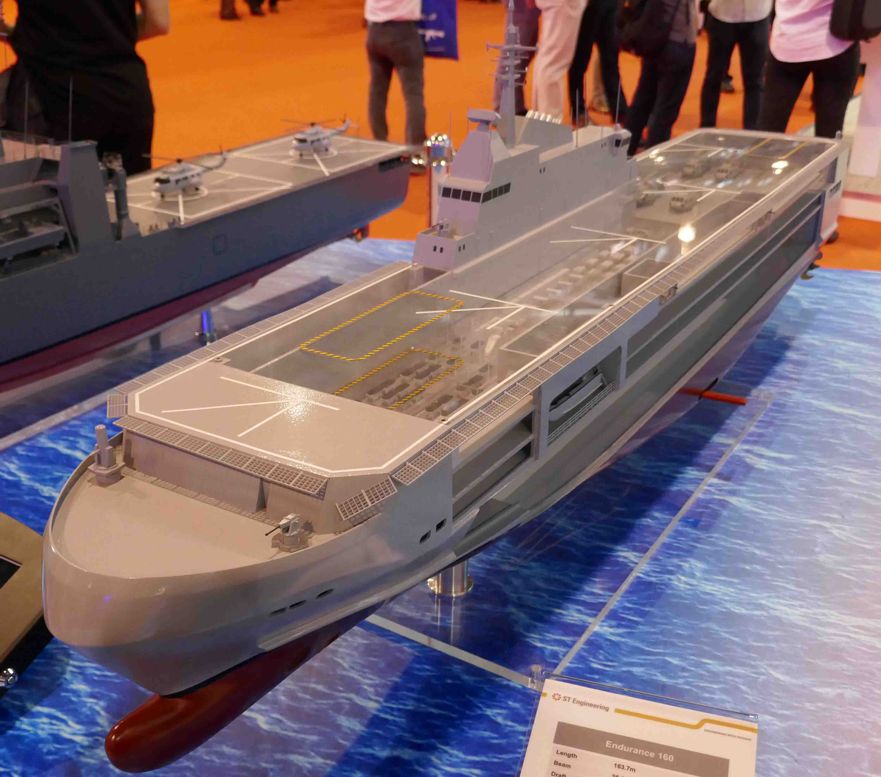
Endurance 160
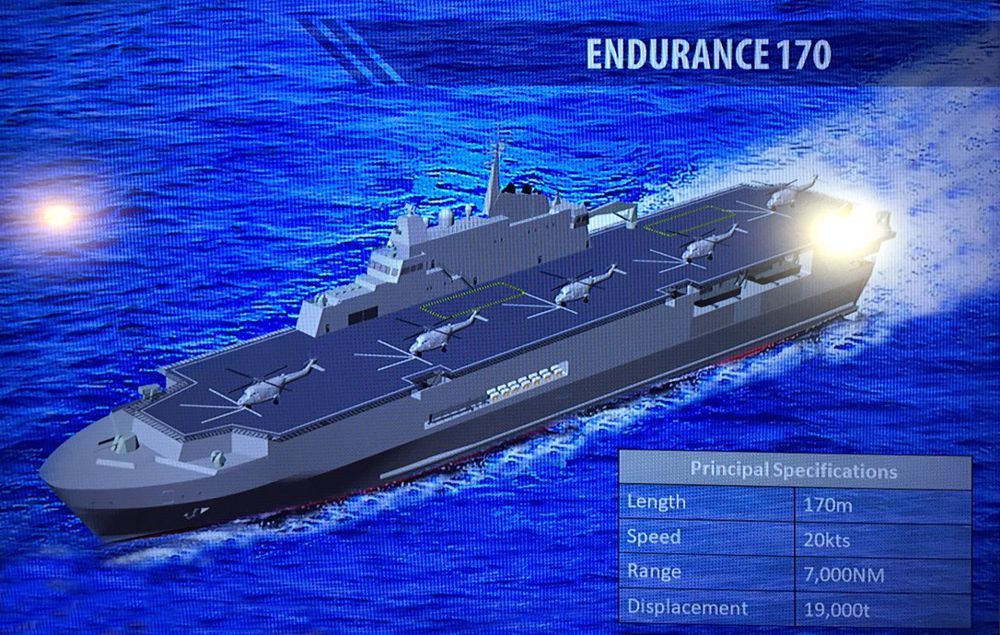
ELLIDA Amphibious / Tanker / Multi-Role Auxiliary Vessel
BMT has unveiled its latest concept design, the ELLIDA™ multi-role support ship, at this year’s international defence trade show DSEI 2019. ELLIDA™ will be the third family of vessels designed by BMT for the auxiliary market and will complement the AEGIR and SALVAS family
The ELLIDA™ concept is underpinned by the proven experience that BMT has gained while designing the AEGIR vessels now in service, the Tide class with the Royal Fleet Auxiliary, and HNoMS Maud with the Royal Norwegian Navy.

The first member of the ELLIDA™ family is a 195m multi-role support and logistics vessel designed to provide the capabilities needed in future global operations, offering the flexibility of a large hull, with an internal vehicle and stowage decks, weather deck stowage and additional accommodation. It has the utility to transport and deliver troops, vehicles, equipment and supplies from anywhere in the world in support of amphibious warfare and littoral maneuver. Its versatile mix of ship-to-shore offloading and logistics capabilities allow support to naval operations through landing craft, boat operations, multi-spot aviation and replenishment at sea.

BMT considered the operational background and future requirements during the development of ELLIDA™ – including the development of operational concepts against current and future doctrines of several navies. The result is a balanced design, able to react to the dynamic operational requirements of military commanders in support of government policy for a number of different nations.

https://www.navalnews.com/event-news/dsei-2019/2019/09/dsei-2019-bmt-unveils-ellida-amphibious-tanker-multi-role-auxiliary-vessel/
Unfortunately I don't know enough about this vessel and what it stats and full capabilities are if they would fully meet the needs set out by the DCP-2019, from the little I do know seems capable enough vessel, HMNZS Canterbury can carry 250 or more depending if trainees are about 285. Ellida is about 350 troops. She can replenish solids to other ships, which Canterbury is very limited at doing.
Around 1000 LMs for wheeled vehicles which I believe is less than Canterbury and possibly fewer helos. Remember even after her alterations HMNZS Canterbury can carry 3 NH-90, plus a SH-2G(I) Seasprite. Has a 5 bed hospital, a two-bed sickbay, an operating theatre, a medical laboratory and a morgue. She also has various workshops, an armoury and magazine, as well as offices for government officials.
I Believe that it may be too much of a multi-vessel to meet the requirements. Another words; I am not sure she will carry enough helos, nor vehicles and equipment in the hold... but the 24 containers and other things are good, although again Canterbury can carry 33 conainters. 8 of which can be ammunition and 4 for hazardous goods.
I also look at the CWIS above the hanger in between the funnels and think... too much of a limited firing arc...?
However appears to a very capable design and concept but may need some tweaking here and there.
VARD-7 313
The VARD-7 313 is a multi-purpose logistics vessel designed as a flexible platform to aid in force projection, maritime special operations, EEZ patrol, and humanitarian assistance. The vessel has significant capabilities for offloading heavy equipment, carrying cargo, transporting troops, launching boats, and supporting aviation.
An internal ro-ro deck accommodates a variety of equipment including tanks, trucks, and ISO containers which can be efficiently loaded from a pier via ramps on the stern and vessel’s side. Two full-breadth cargo holds located beneath the ro-ro deck provide extra storage capacity, while protected areas forward house expansive troop accommodations providing safe and comfortable passage for embarked personnel.
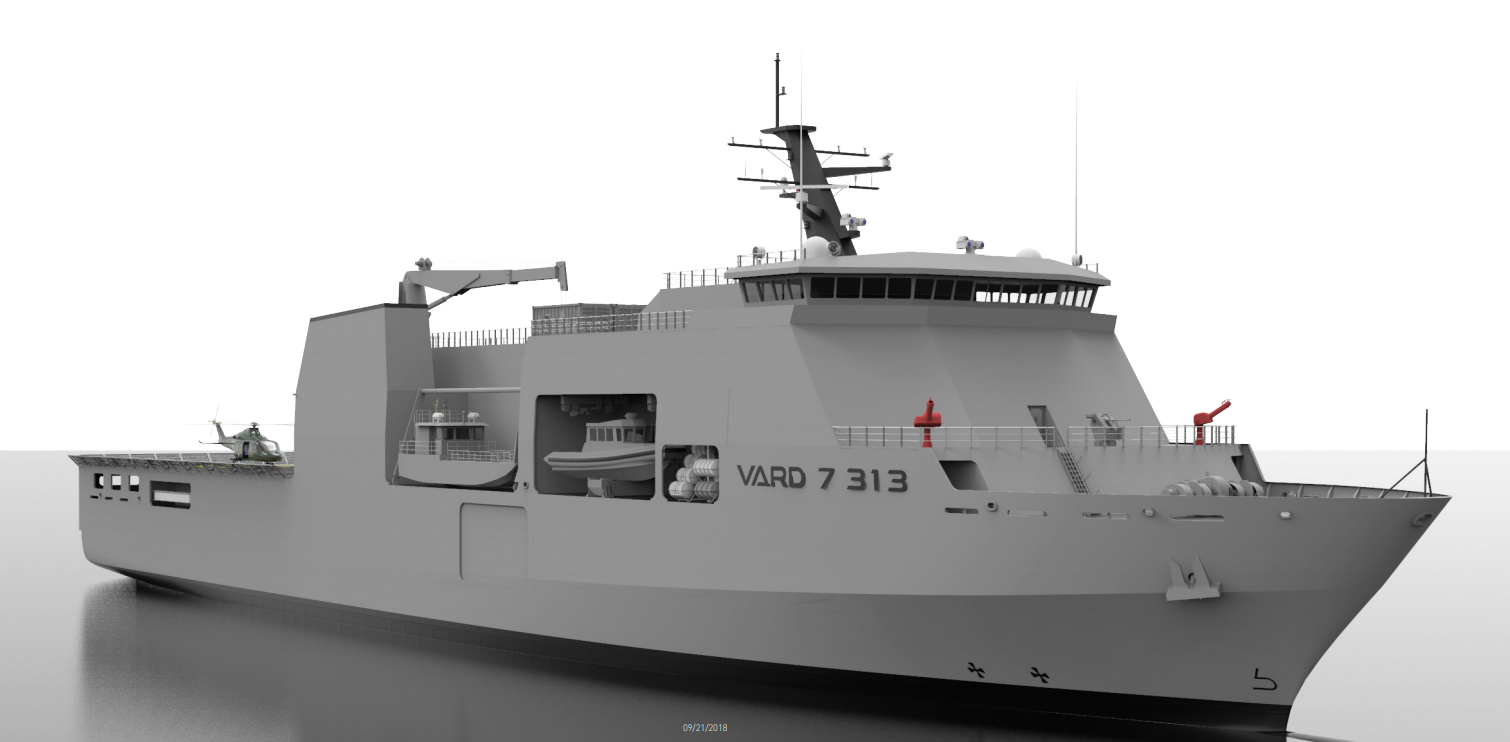
Large open deck areas on each side of the vessel provide secure stowage for two 15 m landing craft and two 11 m RHIBs. Aviation facilities include a flight deck capable of landing two medium lift helicopters and a hangar accommodating four. Expansive medical facilities are readily accessible from the flight and boat decks. Substantial internal area is dedicated to configurable offices and operations areas to support missions.
|
MAIN PARTICULARS
|
PROPULSION MACHINERY
|
|
PERFORMANCE
|
DECK MACHINERY
|
|
TRANSPORT CAPACITIES
|
COMPLEMENT
|
|
FACILITIES
|
ARMAMENT
|
Vard is a trusted vessel designer, and has designed a range of vessels the RNZN's OPV's are based on the VARD-7 90 as is the Irish OPV's. However the VARD-7 313 offers no advance whatsoever from what HMNZS Canterbury can already do, she is a commercial design, she has a Ro Ro stern and side ramp, can hanger 4 medium sized helo's has same as Canterbury.
She has the same or very similar cargo deck. The crane to lower the landing craft is smaller than the two that Canterbury have which x2 60t cranes. Canterbury has this plus she can carry 33 20ft containers. Eight containers of ammunition and up to two with hazardous materials, and also has an extensive fire sprinkler system
The Landing craft are smaller and I don't think they can take the LAV or MHOV vehicles the NZ army use. The weapons are exactly the same.
The dimensions are even very similar. While she can carry a few more troops I don't think it will be enough of an enhancement to consider.
In my view this would be a sideways step not a step forward.
Fincantieri 20,000t LHD
This is the big brother of the Enhance San Giusto Class LPD but smaller than the Trieste Class LHD at only 190m and 20,000tons.
- Length overall: 190 m
- Length between perpendiculars: 167 m
- Max breadth: 33 m
- Moulded breadth: 28 m
- Full load displacement: 20,000 t
- Operational speed: 20 kn
- Range at 16 kn: 7,000 nm
ENERGY AND PROPULSION SYSTEM
- Propulsion diesel engines MMPP: 2 x 11,000 kW + 2 x 6,500 kW
- Diesel generators sets: 4 x 2,500 kW each
HELO CAPABILITIES
- Flight deck for: up to 6 helicopters EH-101 type
- Helicopters hangar for: up to 6 EH-101 type
- Vehicle deck capability: up to 1,200 metric lanes
- Hospital area: abt. 1,000 m² plus 1,000 m² of convertible areas
- Floodable dock: abt. 50 x 15 m
- Vehicle ramps: 1 stern + 1 side
- Accommodation: 200 crew + 750 troops
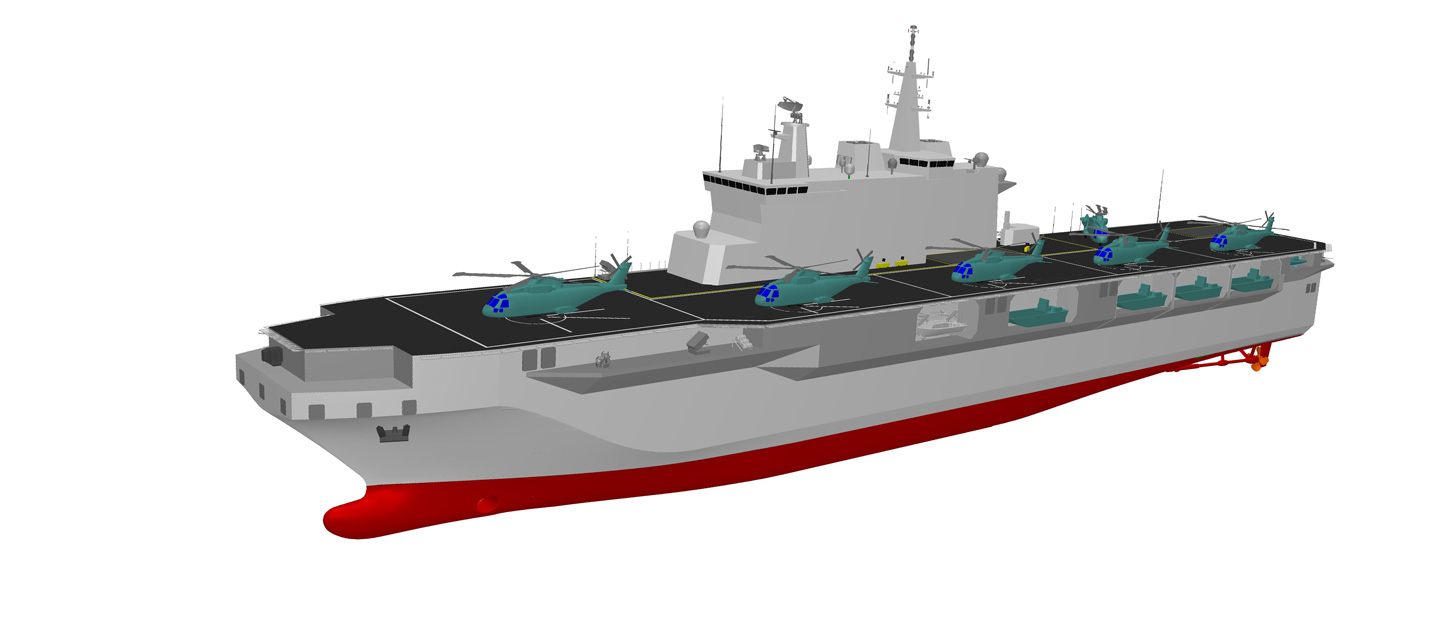
COMBAT SYSTEM
- Air & Surface surveillance system (combined air/surface surveillance radar or air+surface surveillance radars): Mine avoidance sonar
- Artillery: 3 Short Range Gun 25 mm + 2 Otomelara 76/62 SR (acting also as CIWS)
- EW system (ESM/ECM + 2 AAW DLS)
- Torpedo defense (Towed Array + 2 ASW DLS)
- Open architectural command & control system able to be implemented also in later phase (i.e. adding operational functions & operator consoles) (400 m2 available)
- Integrated comms. system (including also the means for landing troops)
- Integrated navigation system (including X and S band navigation radars)
World Wide Landing Ship Dock / Landing Platform Dock
Landing Ship Dock [LSD] and Landing Platform Dock [LPD] can ballast down in the water, thereby flooding the well deck with enough water to enable various sized landing craft to enter the well deck through the stern gate door. Once docked inside the well deck, troops, supplies and combat equipment can be loaded into or off of the amphibious boats and vehicles while simultaneously transporting troops and equipment via helicopter from the flight deck. The LPD has a helicopter platform built over a well deck in the rear of the vessel. This provides the tactical advantage of being able to lift troops, their combat equipment and supplies onto the same ship. Therefore, the ship contributes to all phases of the amphibious assault. The well deck are upper and lower vehicle storage areas, which hold most of the embarked troops' heavy combat equipment, such as tanks, tracked amphibious landing vehicles (AAV), jeeps and trucks. To facilitate the docking and loading of, the ship
Amphibious ship class taxonomies are not precise, have changed over time, and vary from country to country. Amphibious assault ships span a spectrum of capabilities, defined by the relative emphasis on helicopter aviation versus landing craft assets for transporting troops and equipment from sea to shore.
- LST - Landing Ship, Tank: Specialised type for getting tanks or other large vehicles ashore. Unlike other larger amphibious assault vessels, LSTs can beach and discharge directly onto shore.
- Landing Platform, Amphibious [LPA]: Perform the mission of amphibious transport and, amphibious cargo ships. and amphibious dock landing ships. Unlike the LST, the LPA does not beach, but rather carries landing craft on the forward deck and can load cargo from a stern door [the stern is superficially similar in appearance to that of the LSD and LPD, but the deck does not flood].
- Landing Ship Dock [LSD]: Perform the mission of amphibious transports and amphibious cargo ships. Unlike the LST, the LPD does not beach, and unlike the LPA the LPD loads landing craft in an interior well deck. Ships without a docking well must rely on transferring cargo to landing craft via deck-mounted cranes or stern ramps. The effectiveness of either method is heavily dependent on favorable conditions and are generally not feasible above Sea State 1 or 2.
- LPD - Amphibious Transport Dock: Perform the mission of amphibious transports, amphibious cargo ships and amphibious dock landing ships. The difference between a Landing Ship Dock [LSD] and a Landing Platform Dock [LPD] in the US Navy has changed over time. Initially the LPD had a helicopter landing deck, whereas the LSD did not. More recently, while the LSD has acquired a helicopter landing deck, it lacks the helicopter hangar found on the LPD. American LSDs typically carry 400-500 troops, while the LPDs carry 700-900 troops.
- LHD - Landing ship, Helicopter Dock: Multi-purpose amphibious assault ships that can deliver, elements of a landing force by air and amphibious craft. In the US Navy, LHDs have a displacement of over 40,000 tons and the latest LPD has a displacement of about 25,000 tons, though in other navies LPDs run as small as 8,000 tons. In general LHDs are larger than LPDs, though in principle the most obvious difference is that an LPD has a superstructure fore of the flight deck, while an LHD has a full length flight deck and a starboard island [like and aircraft carrier] - the ThyssenKrupp MHD-150 Enforcer series demonstrates the overlap between the two types.
- LHA- Landing ship, Helicopter Assault: General-purpose amphibious assault ships that serve both landing craft and helicopters, with a primary emphasis on aviation rather than landing craft.
- LPH - Landing Platform, Helicopter: Designed to support vertical envelopment helicopter assault, LPHs are similar to conventional aircraft carriers, with flight and hangar decks, though no ski jump or catapult for fixed wing aircraft. facilities. Unlike the LHA, an LPH has no well deck. LHA-6 America will be the first modern US Navy amphibious assault ship without a stern well deck, this being replaced by expanded aviation capabilities, and accordingly she should rather be designated as a LPH.
LSDs and LPDs are generally similar externally, though in the US Navy the LSDs are focused on cargo and LPDs on personnel. US Navy LPDs also carry the medical and staff components for when they split the Expeditionary Strike Group, with the LHA/LHD going in one direction and the LSD with LPD elsewhere. That split allows for detachments that would not be available if it was all big decks. LSD/LPD are also capable of getting into areas the LHA/LHDs are too big and have too deep of a draft.
Many middle-tier navies are reducing their focus on surface combatants and submarines, and improving their capability in naval expeditionary warfare. There is a major increase in the number of amphibious warfare ships entering service in navies big and small, east and west. Various types of amphibious ships are being studied, on order or under construction for navies which have not operated similar warships. LPDs are emerging as key military items for Southeast Asian countries for enhancing naval defense capabilities. The LPD is designed to transport troops into a war zone by sea using landing craft. It embarks, transports and lands soldiers and landing craft and can also be used for landings by helicopters. Even for a comparatively small navy an LPH or LHD makes a lot of sense because of the tremendous range of capabilities and options it can offer a defence force.
The trend toward expeditionary roles has particularly taken hold in Asia. Such expeditionary ships allow countries to play more significant and meaningful roles in joint coalition operations. Making the ships affordable is a major issue in any navy. One approach is to reduce the military requirements which can drive unit costs to over a billion dollars, as with the U.S. Navy's new San Antonio-class LPDs. Other countries can't afford to spend that kind of money on one ship, and so they design their amphibious ships to commercial standards, such as the Rotterdam. Multirole ships can be easier to sell to cash-strapped parliaments. Some navies believe it is a bit less militaristic to call it a vessel a "multipurpose support ship". Warships in some navies are becoming instruments of multinational diplomacy, conducting anti-piracy and disaster relief operations. But by whatever name, it is probably fair to conclude that any state which does not at least operate LSD or LPD types of ships does not have a meaningful amphibious capability.
So let us have a look at how I roughly looked at what New Zealand can afford. I will admit this is not the most accurate way to determine what we can afford as there are other things that need to be taken in to account as well. But it does give a rough indication. So if take for example the Dokdo-class amphibious assault ship in 2005 it cost US$ 296 million.
First add this figure to a inflation calculator and we have our first issue of again this is purely an estimate of inflation. But the 2.5% has been the average over 20 years. It has been a lot higher, but also as low as 0.31% and currently sitting about 1.22%, with a prediction of 1.3% for next year. Future inflation rates can not really be predicted easily but we can only workout on an average. and over all 2.5% seems about right.
https://smartasset.com/investing/inflation-calculator
This gives us a value of Estimated $499 USD. We now have to convert to NZD and another problem here is since the conversation is continuously changing we can not predict the rate. However this one while will change it shouldn't change so drastically in the next 5-9 years that it effects the outcome. And even it went as low as it was in the 1980's we it was as low as 50c which the 499 million would still be just under the 1 Billion 998 million dollars NZD and there is still room for movement as it 1 Billion + more
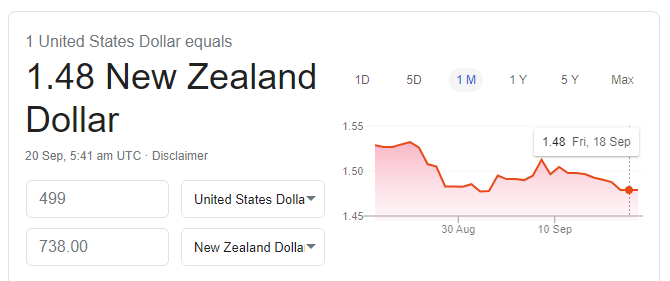
Another thing I have done here is putting into 2029 dollars, however the agreement of cost will be before that as the request for tender is 2024 and introduction into service 2029. So I am guessing in 2025-26 (depending on size of vessel the bigger it is the sooner we need to know) we will get a cost and in that scenario 296 million converts to 450 million and then to NZD 665.53 million.
An example is HMNZS Aotearoa in 2016 with her technology in winterization features, size and capability and even adding in the ice belt, means a higher grade of and thicker steal equates to more cost, of this vessel, she cost $493,000,000 in 2016 dollars. If we now add ten years inflation, and our average rate of 2.5% we get a figure of $627,000,000. But let us say we get lucky for the next 6 years and only have 1.5% inflation. Getting built then would only $592,000,000. Also remember it could go the other way and we get a higher inflation rate meaning we get less for our money and that is we cost cutting happens.
HMNZS Canterbury cost $130,000,000 in 2005 this is a good example as we can get an accurate cost of that to 2020 dollars and that equates to $143,000,000 now add our estimates and in 2026 she would cost $165,000,000. So you can see why I say more than $1,000,000,000 + is very generous and hopefully means the vessel is going to be a very capable addition with a lot fewer cost cuttings and this is why I say 1 Billion + is a lot of money for a LPD and you could get a small LHD like the Singaporean Endurance 170, which is not as large as other LHD's and again built in a Singapore, Korea keeping the costs down etc.
Looking at the Australian Navy procurement of the Canberra Class Amphibious Assault Ships cost at around $1.5 billion AUD each, (around 1.6 billion NZD) the Canberra Class Amphibious Assault Ships had been recently built by Spanish company Navantia in collaboration with British defence contractor BAE Systems-Maritime, using azimuth pods from German manufacturer Siemens. This is vessel is a lot bigger than what we require, at 230m and 27,500t is a lot larger than required, and while the hull was built in Spain it was fitted out in Australia it could have been done a lot cheaper. Saying and meaning that the Endurance 170 (or modified version thereof) at 170m 19,000t, is a lot smaller and would be cheaper, being built in Singapore or South Korea would lower this cost even more. Overall a modified Endurance 170 Class LHD would easily be in the more than 1 billion dollar budget.
|
DCP19 or DCP 2019
|
Defence Capability Plan 2019
|
NZG
|
New Zealand Government
|
|---|---|---|---|
|
MoD
|
Ministry of Defence
|
LPD
|
Landing Platform Dock
|
|
NZG
|
New Zealand Government
|
LHD
|
Landing Helicopter Dock
|
|
NZDF
|
New Zealand Defence Force
|
HMNZS
|
His/Her Majesty New Zealand Ship
|
|
NZD
|
New Zealand Dollar
|
RNZN
|
Royal New Zealand Navy
|
|
USD
|
United States Dollar
|
|
|






